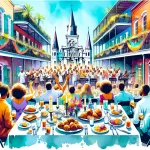New Orleans is the undisputed birthplace of jazz, a musical genre that has captivated audiences worldwide with its soulful melodies, intricate rhythms, and improvisational spirit. This city has nurtured countless legendary musicians and fostered a rich cultural heritage that continues to thrive in its iconic music venues. From intimate clubs to historic halls, these establishments have become sacred grounds for jazz enthusiasts, offering a unique blend of musical excellence and cultural immersion.
In This Article
TL;DR
- New Orleans‘ jazz scene has played a pivotal role in shaping the city’s musical identity and influencing the global music landscape.
- Venues like Preservation Hall, The Spotted Cat Music Club, and Snug Harbor Jazz Bistro have become synonymous with the authentic New Orleans jazz experience.
- These venues showcase exceptional talent, boasting unique architectural and cultural elements that contribute to their iconic status.
Historical Context of Jazz in New Orleans
Jazz emerged from the convergence of cultures in New Orleans in the late 19th and early 20th centuries. The city’s African-American communities, particularly in neighborhoods like Tremé and Storyville, played a pivotal role in the genre’s development. Early jazz pioneers like Buddy Bolden, Jelly Roll Morton, and King Oliver laid the foundations for what would become a global phenomenon.
Venues like Buddy Bolden’s Funky Butt Hall and the legendary Storyville district provided a stage for these trailblazers, allowing them to experiment with new sounds and styles. As jazz evolved, so did the venues that hosted it, with iconic establishments like Preservation Hall and The Spotted Cat Music Club becoming integral parts of the city’s cultural fabric.
Iconic Jazz Venues in New Orleans
Preservation Hall
Located in the French Quarter, Preservation Hall is a true icon of New Orleans’ jazz heritage. Established in 1961, this intimate venue has become a mecca for traditional New Orleans jazz, attracting music lovers from around the world. The Preservation Hall Jazz Band, a rotating ensemble of some of the city’s finest musicians, performs nightly in the hall’s cozy confines, transporting audiences back to the golden age of jazz.
The Spotted Cat Music Club
Located on the lively Frenchmen Street, The Spotted Cat Music Club is a beloved haunt for jazz enthusiasts and local musicians alike. This unassuming venue has become a breeding ground for emerging talent, showcasing a diverse range of jazz styles from swing to modern interpretations. With its intimate atmosphere and a constant stream of live performances, The Spotted Cat embodies the essence of New Orleans’ vibrant jazz scene.
Snug Harbor Jazz Bistro
Snug Harbor Jazz Bistro is an oasis for jazz aficionados, offering a unique blend of exceptional music and culinary delights. This Frenchmen Street institution has hosted some of the biggest names in jazz, from Allen Toussaint to Ellis Marsalis, while also nurturing up-and-coming artists. With its sophisticated ambiance and impeccable acoustics, Snug Harbor provides an unforgettable experience for both locals and visitors.
Maple Leaf Bar
Located in the Uptown neighborhood, the Maple Leaf Bar has been a staple of the New Orleans music scene since 1974. This iconic venue hosts weekly performances by renowned acts like the Rebirth Brass Band, offering a variety of jazz, funk, and blues. The Maple Leaf’s intimate setting and lively atmosphere have made it a favorite among music lovers and a breeding ground for emerging talent.
Tipitina’s
Tipitina’s is more than just a music venue; it’s a cultural institution that has played a pivotal role in preserving and promoting New Orleans’ rich musical heritage. Founded in 1977 as a performance space for Professor Longhair, this iconic establishment has hosted countless legendary acts, from Dr. John to the Neville Brothers. With its eclectic programming and commitment to supporting local artists, Tipitina’s continues to be a driving force in the city’s vibrant music scene.
Architectural and Cultural Significance
The iconic status of these venues extends beyond their musical offerings. Their unique architectural elements and cultural significance contribute to the overall experience, transporting visitors to a bygone era while celebrating the city’s rich heritage.
From the exposed brick walls and intimate ambiance of The Spotted Cat to the historic charm of Preservation Hall, each venue boasts a distinct character that resonates with the spirit of New Orleans. The cultural impact of these establishments on their surrounding neighborhoods is undeniable, serving as gathering places for locals and fostering a sense of community.
Current Role and Influence
While steeped in history, these iconic venues continue to shape the future of jazz in New Orleans and beyond. They serve as incubators for emerging talent, providing a platform for young musicians to hone their craft and carry on the city’s musical legacy. Additionally, their global reputation attracts jazz enthusiasts from around the world, further solidifying New Orleans’ status as a cultural mecca.
Recent renovations and developments at some of these venues, such as the expansion of Preservation Hall and the revitalization of Tipitina’s, demonstrate their commitment to preserving their rich histories while adapting to the evolving needs of the music community.
Community and Cultural Engagement
Beyond their musical offerings, these iconic venues play a vital role in engaging with the local community and promoting cultural education. Many of them host workshops, masterclasses, and educational programs aimed at nurturing the next generation of jazz musicians. Partnerships with local schools, cultural organizations, and festivals further solidify their commitment to preserving and celebrating New Orleans’ musical heritage.
Preservation Efforts and Challenges
While these venues have stood the test of time, they face ongoing challenges in terms of preservation, modernization, and competition. Maintaining the delicate balance between preserving their historical significance and adapting to modern demands is an ongoing endeavor.
Fortunately, these efforts have been bolstered by support from both local and international communities, who recognize the invaluable cultural and artistic contributions of these iconic establishments. Successful preservation initiatives, such as the Preservation Hall Foundation’s efforts to restore and maintain the venue, have ensured that these treasures remain accessible to future generations.
Expert Insights and Future Outlook
As New Orleans’ jazz scene continues to evolve, these iconic venues remain at the forefront, serving as guardians of the city’s musical heritage while embracing innovation and creativity. Musicians, historians, and cultural experts alike recognize the vital role these establishments play in shaping the city’s cultural identity and influencing the global perception of New Orleans jazz.
With a renewed focus on preservation, community engagement, and nurturing emerging talent, these iconic venues are poised to continue their legacy as beacons of artistic expression and cultural enrichment for generations to come.






